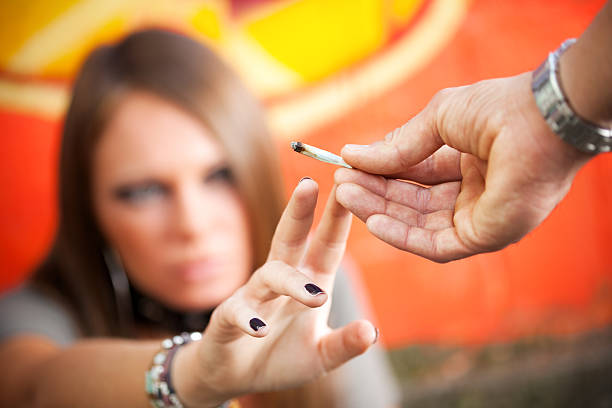From Truancy to Recovery: A Look at Youth Drug Abuse in Singapore
Youth drug abuse in Singapore, while seemingly distant, is a growing concern fueled by curiosity and societal pressures. Join MISHAEL LEE as he questions the battleground and seeks a new front in the fight against youth addiction.
BY
Mishael Lee
Lead Designer
Hype Issue #59
Published on
August 23, 2024

Photo courtesy of Canva.
As reported by Channel News Asia, the number of new drug abusers under the age of 30 increased by 20% in just one year. In early February of this year, the Central Narcotics Bureau (CNB) reported that three young girls had been arrested for abusing ice, following the arrest of “many traffickers” in 2023 as the CNB dismantled 25 drug syndicates. The impact of drug abuse extends beyond the individual abuser, often devastating families and communities as well.
Singapore is periodically jolted by alarming headlines about “worrying” surges in youth drug abuse. News outlets question the efficacy of anti-drug campaigns, while the government, in tandem with the CNB and youth-centric organisations, frantically devise new strategies to deter young people from drug abuse.
Yet, the reality for many youths like myself, who spent their formative years in a neighbourhood school, feels vastly different. The idea of drug abuse seems distant, a concept primarily confined to disciplinary talks and sensationalised news reports. “Methamphetamine” was as terrifying to us as “Voldemort” was to young Harry Potter fans.
This disconnect between the perceived reality of drug abuse and the intense public discourse creates a strange situation. Many young people, including myself, wonder if we are truly battling an imaginary enemy.
This uncertainty is a double-edged sword. It can fuel excessive fear of addiction, causing unnecessary anxiety. On the other hand, a dangerous curiosity chips at the back of their minds: “Maybe it’s not as harmful as they say. Can I control it?”
When Curiosity Kills the Cat: The Gateway to Drug Abuse

Peer pressure and avoiding problems can lead to drug abuse among youths. Photo courtesy of iStock.
This internal conflict can be a slippery slope, tempting inquisitive young minds to experiment and test boundaries. “One of the main reasons why youths in Singapore take drugs is actually curiosity,” Ms. Nuramira Rosli, a Counsellor at Youth Service @ Singapore Children’s Society affirmed.
An IMH survey released last year showed that more than one in five young people who have tried illicit substances say curiosity got the best of them. Yep, you read that right — pure curiosity led a whopping 21.6% to take the plunge. Peer pressure and the desire to run away from problems such as trauma, mental health issues, high levels of stress, and an incapacity to deal were two more prevalent reasons.
Ms. Hannah Chun, a former drug abuser and volunteer at halfway houses, echoes this view, suggesting that the inaccessibility of drugs here creates an allure, she comments. “People are hearing from social media, where others boast about recreational drug usage,” Chun stated.
In contrast, she points to countries where drugs are readily available, where the overt negative consequences deter experimentation. “Overseas, what we see is very different. The drug abusers roam the streets and the government does not step in to help at all,” she observed.
“If we address that curiosity by being open to talk about drugs, it helps in the preventive side,” Ms. Rosli asserted. “I think it also discourages them from trying [drugs] first.”
A Two-Way Street: Society’s Role in Addiction Recovery

True healing and recovery from drug abuse requires mutual understanding. Photo courtesy of iStock.
However, youthful curiosity is not the sole culprit. The importance of societal acceptance of drug abusers and recovering addicts has grown since the government announced last May that it was forming an inter-ministry committee to investigate how it can collaborate with parents, schools, the community, and other stakeholders to prevent youth drug abuse.
“I think the first thought is always to change, right? You need action,” Chun reflected, describing her recovery journey.
“When seeking a change of environment, the people around you may not be equipped to handle it,” she lamented. “So, that’s why I think many of us give up. We often feel misunderstood. We often have a lot of struggles. So, we feel that society is not giving us a chance.”
While Singapore uses a variety of traditional and digital channels to spread the anti-drug message, we must recognise that Preventive Drug Education (PDE) programmes cannot exist in a vacuum. We cannot assume that a youth will readily commit to stay drug-free after a PDE talk or programme. The conditions in society must facilitate a drug-free way of life.
However, while abusers often seek multiple chances from society, it is essential to recognise that mutual understanding is key to recovery. Abusers often feel misunderstood and use this as an excuse to give up, but society also lacks firsthand experience with addiction, leading to blame and judgement.
“I always tell [drug abusers], can you give people a chance?” Chun explained. “People have never been through what they’ve been through. So sometimes they end up with finger pointing, blaming, because they did this to me. This is why some abusers don’t want to go back to counselling sessions.”
Effective recovery requires a two-way effort: abusers must also give society a chance to understand, rather than solely expecting patience and acceptance. “It takes two hands to clap,” Chun re-asserted.
Changing the way we discuss drug abuse with our youths
It is no surprise that Singaporean youths are remarkably intelligent, often possessing a sophisticated understanding of all the fancy psychological terms and the ability to talk circles around most adults. However, this intelligence may paradoxically make efforts to stop drug usage more difficult, and how their critical thinking skills might lead them to question authority or conventional wisdom.
“I think Singaporean youths are very intelligent. They will joke about certain emotional issues. They are well-versed in knowing all the psychology terms, everything,” Chun observed. “It’s more like they don’t want to be controlled. They want to be convinced.”
Like Chun, Ms. Rosli also believes that open and honest communication, or authenticity, is crucial when engaging with youth about sensitive topics like drug abuse. “I think that’s what we need to do with our youth. To be able to share openly about the struggles that we have,” she acknowledged.
However, defining authenticity in conversations with youth about drug abuse is complex. While it is crucial to be open and honest, it is equally important to recognize that young people often approach information with a critical eye, especially when it comes from adults. Their perceptions can be influenced by various factors, including peer pressure, media, and personal experiences. Therefore, establishing trust and credibility is essential for effective communication.
“We cannot stop at just saying, drugs are wrong, stop, don’t use,” Ms. Rosli believes. “So [youths] might say certain things like, drugs are cool. Then you might have to say, oh, what about it is cool?”
Ultimately, creating a safe space is key to open conversations about drug abuse. While it is understood that drug abuse casts a wide net, affecting not just abusers but the loved ones and communities around them, adults need to show they genuinely care by being curious and open-minded. Asking questions without judgement can help young people feel heard and understood. When someone feels listened to, they are more likely to share their thoughts honestly. Remember, shutting down a conversation with judgmental remarks only creates distance.

Ny weekly I’m often to blogging and i really appreciate your content. The article has actually peaks my interest. I’m going to bookmark your web site and maintain checking for brand spanking new information.
Ny weekly I like the efforts you have put in this, regards for all the great content.
I was suggested this web site by my cousin. I’m not sure whether this post is written by him as no one else know such detailed about my trouble. You are incredible! Thanks!
I do believe all the ideas you’ve presented for your post. They are really convincing and will certainly work. Nonetheless, the posts are too short for novices. May just you please lengthen them a little from subsequent time? Thanks for the post.
Its like you read my mind! You appear to know a lot about this, like you wrote the book in it or something. I think that you could do with some pics to drive the message home a little bit, but instead of that, this is fantastic blog. An excellent read. I will certainly be back.
SERP özellikleri Google SEO ile hedef kitlemize daha kolay ulaşıyoruz. https://www.royalelektrik.com/gulsuyu-elektrikci/
DMCA kaldırma talebi Google SEO sayesinde online satışlarımız arttı. https://www.royalelektrik.com/moda-elektrikci/
This was a great read! I appreciate the effort you put into explaining this topic. It’s always refreshing to come across well-written content like this. Keep up the good work, and I can’t wait to see more of your posts!
SEO rehberi SEO optimizasyonu, web sitemizin performansını optimize etti. https://www.royalelektrik.com/osmanaga-elektrikci/
DMCA yasal süreç SEO hizmetleri ile Google sıralamalarında ciddi bir artış sağladık. https://www.royalelektrik.com/fiber-kablo-tamircisi/
BaddieHub Great information shared.. really enjoyed reading this post thank you author for sharing this post .. appreciated
I am not sure where youre getting your info but good topic I needs to spend some time learning much more or understanding more Thanks for magnificent info I was looking for this information for my mission
Hi Neat post There is a problem along with your website in internet explorer would test this IE still is the market chief and a good section of other folks will pass over your magnificent writing due to this problem
Nutra Gears This was beautiful Admin. Thank you for your reflections.
Thank you for the auspicious writeup It in fact was a amusement account it Look advanced to more added agreeable from you By the way how could we communicate
Fantastic beat I would like to apprentice while you amend your web site how could i subscribe for a blog site The account helped me a acceptable deal I had been a little bit acquainted of this your broadcast offered bright clear concept
I have read some excellent stuff here Definitely value bookmarking for revisiting I wonder how much effort you put to make the sort of excellent informative website
My brother suggested I might like this blog He was totally right This post actually made my day You can not imagine simply how much time I had spent for this info Thanks
Copper-Nickel Pipes in Iraq Elite Pipe Factory provides copper-nickel pipes that are known for their excellent corrosion resistance and durability, making them ideal for marine and industrial applications. These pipes are crafted with precision to meet the high demands of various industries. As one of the most trusted and reliable manufacturers in Iraq, Elite Pipe Factory ensures that our copper-nickel pipes deliver superior performance and longevity. For more details, visit elitepipeiraq.com.
أنابيب المايكرو دوكت في العراق في مصنع إيليت بايب، نقدم بفخر أنابيب المايكرو دوكت الممتازة في العراق، المصممة لتوفير أعلى مستوى من الأداء والموثوقية. أنابيب المايكرو دوكت لدينا مثالية لشبكات الاتصالات والبيانات، حيث تضمن التثبيت السلس والتشغيل الفعال. كواحدة من أفضل وأهم الشركات المصنعة في العراق، تجمع شركة إيليت بايب بين التكنولوجيا المتقدمة ومعايير الجودة الاستثنائية لتقديم منتجات تفي وتتجاوز توقعات الصناعة. لمزيد من المعلومات حول أنابيب المايكرو دوكت لدينا، تفضل بزيارة موقعنا الإلكتروني على elitepipeiraq.com. التزامنا بالابتكار والتميز يجعلنا خياراً موثوقاً لمشاريع البنية التحتية في جميع أنحاء البلاد.
먹튀검증 전문가들이 꼼꼼하게 검증한 사이트만을 소개합니다. 안심하고 베팅하세요.
Fantastic site Lots of helpful information here I am sending it to some friends ans additionally sharing in delicious And of course thanks for your effort
먹튀검증소: https://mtverify.com/
certainly like your website but you need to take a look at the spelling on quite a few of your posts Many of them are rife with spelling problems and I find it very troublesome to inform the reality nevertheless I will definitely come back again
real estate shop Nice post. I learn something totally new and challenging on websites
BYU Cougars There is definately a lot to find out about this subject. I like all the points you made
Blue Techker very informative articles or reviews at this time.
Your blog is a breath of fresh air in the often stagnant world of online content. Your thoughtful analysis and insightful commentary never fail to leave a lasting impression. Thank you for sharing your wisdom with us.
Thinker Pedia I truly appreciate your technique of writing a blog. I added it to my bookmark site list and will
Thinker Pedia Hi there to all, for the reason that I am genuinely keen of reading this website’s post to be updated on a regular basis. It carries pleasant stuff.
Thinker Pedia This is really interesting, You’re a very skilled blogger. I’ve joined your feed and look forward to seeking more of your magnificent post. Also, I’ve shared your site in my social networks!
Real Estate Nice post. I learn something totally new and challenging on websites
Nice blog here Also your site loads up fast What host are you using Can I get your affiliate link to your host I wish my web site loaded up as quickly as yours lol
Noodlemagazine Good post! We will be linking to this particularly great post on our site. Keep up the great writing
Your blog is a beacon of light in the often murky waters of online content. Your thoughtful analysis and insightful commentary never fail to leave a lasting impression. Keep up the amazing work!
Simply desire to say your article is as surprising The clearness in your post is simply excellent and i could assume you are an expert on this subject Fine with your permission let me to grab your feed to keep up to date with forthcoming post Thanks a million and please carry on the gratifying work
Baddiehub I do not even understand how I ended up here, but I assumed this publish used to be great
Blue Techker very informative articles or reviews at this time.
Blue Techker I like the efforts you have put in this, regards for all the great content.
Rely on BWER Company for superior weighbridge solutions in Iraq, offering advanced designs, unmatched precision, and tailored services for diverse industrial applications.
Hello i think that i saw you visited my weblog so i came to Return the favore Im trying to find things to improve my web siteI suppose its ok to use some of your ideas
Noodlemagazine This is my first time pay a quick visit at here and i am really happy to read everthing at one place
Noodlemagazine I appreciate you sharing this blog post. Thanks Again. Cool.
Noodlemagazine This was beautiful Admin. Thank you for your reflections.
Noodlemagazine I like the efforts you have put in this, regards for all the great content.
Noodlemagazine Hi there to all, for the reason that I am genuinely keen of reading this website’s post to be updated on a regular basis. It carries pleasant stuff.
Noodlemagazine Very well presented. Every quote was awesome and thanks for sharing the content. Keep sharing and keep motivating others.